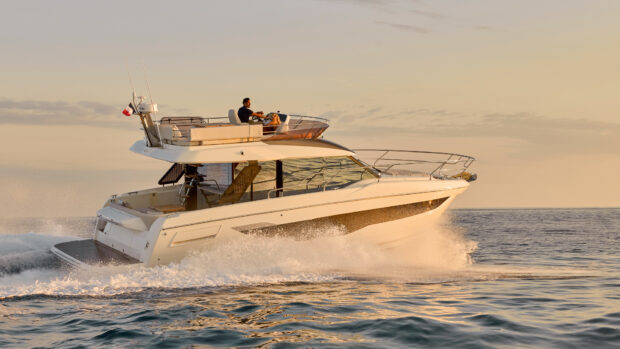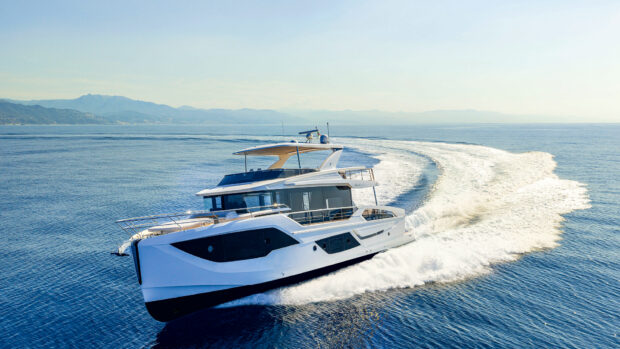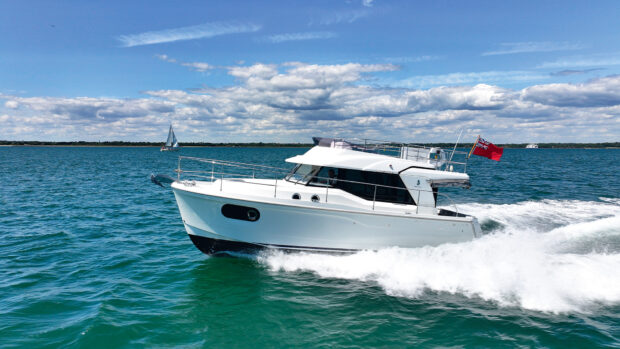The Broom 415 OS, is a twin-cabin cruiser with a wealth of spacious accommodation below decks, but has she stood the test of time?
A word that comes up time and again when reviewing mid-sized used boats is ‘compromise’. A smaller cabin here to accommodate a larger galley there; a single heads so you can squeeze in an extra berth. It seems that something always has to give.
A boat builder who could crack this maritime conundrum by providing a layout that could satisfy everyone would be onto something truly special, wouldn’t they? Well maybe, but then again…
The case in point here is the Broom 415 OS, a twin-cabin cruiser with a wealth of spacious accommodation below decks. Not only is there a whopping split-level saloon with a substantial galley and dinette, there’s also a sizeable full-beam aft master cabin, a more-than-adequate guest cabin, two spacious washrooms and a shower room to boot.
The key to achieving all of this is the boat’s helm position. Rather than cluttering up the saloon with a steering wheel and a bunch of levers and instruments, Broom has shifted the whole shebang outside. As a result, the internal space is truly exceptional for a 41-footer.
So perhaps the biggest surprise of all is that just 12 Broom 415 OSs were ever built.

Full canopy covers means the outdoor helm can be used come rain or shine
The fact of the matter is that Norfolk-based Broom Boats was never a volume producer. In its eyes, quality always deserved to triumph over quantity and as such, its vessels can generally be relied upon for high-quality craftsmanship and a very good standard of finish.
That’s very much the case with the 415 OS. Launched at the turn of the century, the 415 OS (Offshore) was the largest model in the OS range. It superseded the 41, an older aft cabin craft based on the John Bennett-designed 39 hull – and five years on, the 415 OS would itself be superseded by the 42 series, as Broom slowly but surely upped the size of its range. But in concept and execution, it remains very much a flagship boat and that shows in the details.
Helm at the hub
Sandwiched at deck level between the rear of the saloon and the aft cockpit, the external helm stays firmly rooted at the centre of the boat, so it incurs none of the separation you tend to get with a flybridge. Another noteworthy point is that removing all the covers around the helm gives this boat a genuine open feel.
The helm location also provides fantastic all-round visibility and there’s a neat double-sided seating unit, which provides three forward-facing seats at the helm, backed up by three rearward-facing seats for the aft cockpit.
Article continues below…

Best 40ft family flybridge boats on the market now

Jeanneau Merry Fisher 1095 used boat review: a lot of boat for the money
It’s a very sociable set-up and the aft cockpit is also distinctly generous. In addition to those three seats, there’s a drop-leaf table and a bench, which wraps its way around the transom and the starboard quarter. The transom gate can be blocked off with an infill panel to extend the bench over to the port quarter seat, creating an enormous full-beam U-shaped unit big enough for the full ship’s complement of ten.
In fact, it’s only when exiting the boat via the transom that the steep steps and the compact aft platform begin to feel a bit tight. Perhaps a hint of compromise after all!
That said, the aft cockpit also provides access to the side decks, where the guardrails incorporate a pair of side gates and a set of handy fender baskets. Moving forwards involves negotiating two downward steps, so caution is required here.

The elevated aft cockpit backs directly onto the triple helm seats
And when you get to the bow, no provision is made for sunpads on the foredeck, but with a little imagination and a couple of towels, that’s not to say you couldn’t rig it for a spot of summer lounging.
Access to the saloon and below decks accommodation is achieved via the boat’s companionway, which is secured by a two-part fully glazed unit. You simply slide the roof section back, open up the door and you’re in. It looks a bit dated by modern standards, but it does a fine job of keeping out the elements while letting the sunshine in.
From here, four quite steep steps lead down to a cavernous saloon, which features a super-comfy six-seater settee, a coffee table and a stylish sideboard and storage unit along the port side. Further ahead, another two steps take you down to an inviting (and very sizeable) dinette and galley.
There’s a forward washroom ahead of this, with Jack and Jill doors so you can use it either as an ensuite or a day heads. And in the forepeak lies a very decent vee berth for guests, with excellent separation from the master cabin aft. That’s accessed by means of another set of steps at the back end of the saloon and it’s very much the star attraction of the lower deck.

Recent upgrades include a Raymarine MFD, an AIS-equipped VHF and a radar
In addition to lots of space and storage, there’s an ensuite bathroom with a toilet and washbasin on the starboard side plus a large separate shower compartment that has you questioning just how big this boat actually is.
Fervent fans
As a consequence of Broom’s commitment to small-volume production, Broom owners tend to be very loyal fans of the brand, and that proved to be exactly the case with the two 415 OS owners we caught up with in the process of preparing this article. Firstly, we spoke to Terry Bishop, whose 2001 Broom 415 OS is the one featured here and is on the books with Ancasta’s Lymington office for £199,950, tax paid.
“I don’t want to sell it, but I’m 81 and it’s now difficult for me to run around the boat,” says Terry. “I’ve had it virtually from new. The person who originally had this boat went to do the final inspection up in Brundall, where he tragically received a phone call to say his wife had died.

The full-beam aft cabin is very spacious and private for a boat of this length
“She had designed the inside of the boat and, understandably, he no longer wanted it. It went on the stand at the London Boat Show in 2002, which is why it’s got little carpets here and there, where they’re not normally put in. I bought the boat unused, so realistically it’s been one owner from new.”
Today, with more than 1,500 hours on its Caterpillar 3126TA 355hp engines, Terry’s boat has been meticulously maintained and upgraded over the years.
“I have an engineer who has looked after it from new,” he says. “He knows everything about the boat and keeps it in perfect condition. Everything works and it’s ready to go!
“In terms of upgrades, we’ve recently fitted a new radar system and a Raymarine HybridTouch multi-function display. There’s also a brand new Icom IC-M510 radio with AIS. As for seakeeping, well if you mean its ability to go from A to B in a rough sea, then it’s great.

A really generous forward galley is ideally placed to serve the dinette opposite
“I’ve been out in a Force 9 on the Solent between Yarmouth and our base in Hythe. There was more water over the boat than under it at times, but I had no alternative but to keep going. She handled exceptionally well – she does in any weather – and you can turn her on a sixpence, which makes manoeuvring easy.
“I tend to cruise at about 12 knots and it’s a very smooth running boat. But up on the plane she’s good for around 25 knots, even with full fuel and water tanks and four people on board.”
The upsizer’s perspective
The second owner we contacted was Norfolk-based Broom Owners’ Club member, Joanna Smith, who at the time was in the process of trading up to a Broom 425. “What we particularly like about Brooms is that they are designed for inland waterways as well as the sea, and there’s not many designed for both,” says Joanna.

The Broom layout positions the two sleeping cabins at opposite ends of the boat
“The folding radar arch is a big plus point, as you can go underneath bridges in Europe and the Norfolk Broads. We do most of our boating on the Broads but we also do big trips to Holland. We go out to sea probably four times a year and she’s always handled the conditions well.
“In fact, we weren’t looking to change but the 425 suddenly came up. We were moored at Broom, having some work done and we could see the 425 for sale. It’s very much like the 415 but with a third cabin.”
In spite of all the positive commentary, it has to be remembered that the Broom 415 OS is a 20-year-old product. As such, its lines are more classic than modern. But don’t let that put you off. It’s still a good looking boat and it’s capable of handling all manner of conditions.
Our main criticisms concern the steep steps to the aft cockpit and the saloon; and the restricted engine access, which involves shifting the coffee table and removing several settee panels to expose the hatch. Even then, it’s only good for daily checks, as major servicing requires the whole settee to be taken apart. But if, like Terry, the big maintenance jobs are taken on by a trusted friend, that’s not a problem.

The saloon is accessed through a glass hatch to port of the helm
In return for putting up with a few grumbles, you’d be getting a 41-footer that punches well above its weight.
Broom 415 OS specifications
LOA: 41ft 2in (12.55m)
BEAM: 13ft 6in (4.11m)
DRAFT: 4ft 3in (1.3m)
DISPLACEMENT: 10.0 tonnes light, 11.5 tonnes loaded
FUEL CAPACITY: 2 x 570 litres (125 gallons)
WATER CAPACITY: 500 litres (110 gallons)
TOP SPEED: 31.2 knots (with twin 420hp Caterpillar 3126 engines)
FUEL CONSUMPTION: 3.58l/Nm @ 19 knots
RANGE: 232Nm at 14.9 knots with 20% reserve
CURRENT PRICE RANGE: £190,000 – £230,000
Broom 415 OS running costs
Annual fuel burn: 840 litres (based on 25 hours at 26.1 knots and 25 hours at 6 knots)
Berthing: £8,875 (based on £710/metre for a Hamble River marina downstream of Bursledon bridge)









